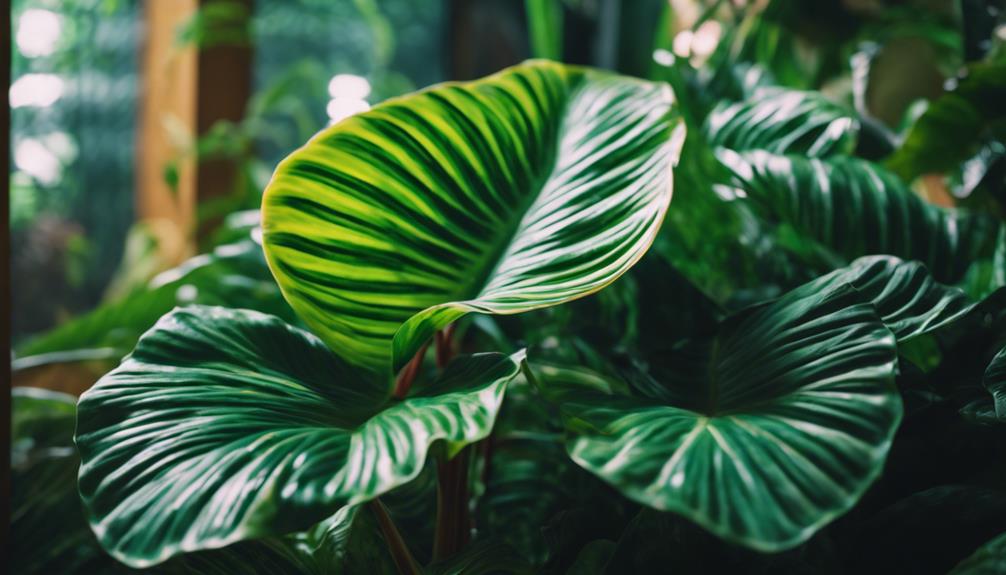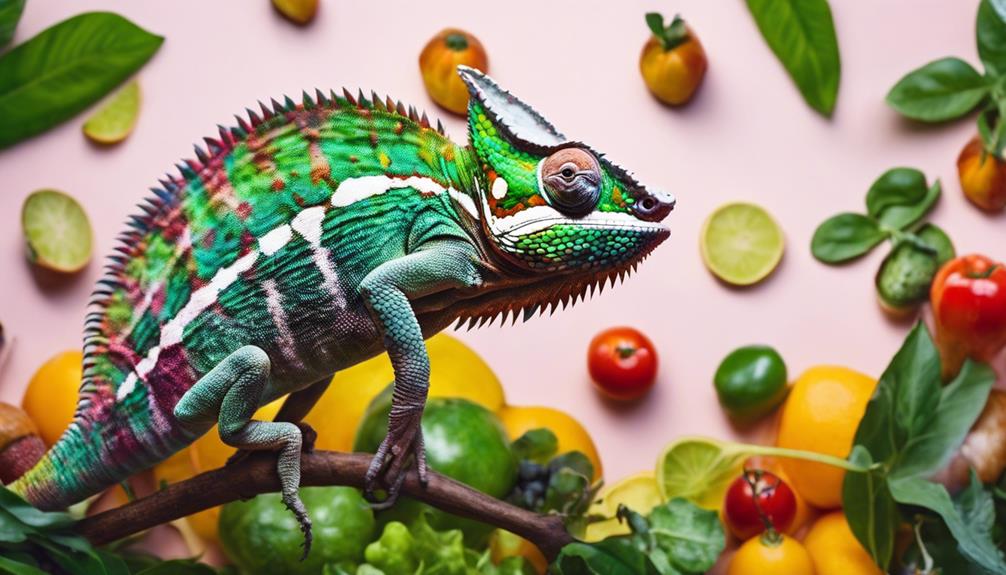If you've ever wondered about the compatibility of Calathea plants with chameleons, the answer might surprise you. While Calathea is generally safe for chameleons, there are some considerations to ponder.
Imagine a scenario where a chameleon owner introduces Calathea to their enclosure, only to notice peculiar changes in their pet's behavior. What could be causing this shift, and how can it be addressed?
Understanding the nuances of this plant-chameleon dynamic could be vital for the well-being of your scaly friend.
Potential Risks of Calathea for Chameleons
When considering the potential risks of incorporating Calathea plants into your chameleon's habitat, understanding their specific characteristics and how they may impact your pet's well-being is important.
Calathea plants are generally safe for chameleons, with no reported toxicity risks. They provide essential hiding spaces, contributing to the enrichment of your chameleon's environment. These plants require high humidity levels, which align with the habitat needs of chameleons, aiding in their overall health and well-being.
While Calathea plants may not offer sturdy climbing support, they serve as beautiful decorative elements in your chameleon's habitat. Understanding the care needs of Calathea plants is essential to make sure they thrive in your chameleon's environment.
Safe Plant Alternatives for Chameleons
For chameleons seeking safe and suitable plant alternatives in their enclosures, options such as Peperomia prostrata, Cissus amazonica, Tillandsia concolor, Neoregelia bromeliads, and Macodes petola can be considered. These plants are potentially safe for chameleons and provide an enriching environment for them.
When selecting plants for your chameleon's habitat, consider the following:
- Peperomia prostrata: Known for its low maintenance and secure for chameleons.
- Tillandsia concolor: Air plants like Tillandsia concolor aren't only safe but also add a unique touch to the enclosure.
- Neoregelia bromeliads: These bromeliads provide a secure foliage option for chameleons to explore.
Choosing safe plants is essential as some aroids can be toxic to chameleons if ingested. To assure the well-being of your chameleon, opt for these safe alternatives that not only enhance the aesthetic of the enclosure but also provide a secure environment for your pet.
Toxicity Levels of Calathea to Chameleons
Calathea plants are recognized as safe options for chameleons, displaying no reported toxicity concerns. They are considered safe plants for pets, including chameleons, and can be incorporated into chameleon enclosures without posing any known risks. Some online resources even recommend using Calathea plants in chameleon habitats due to their safety and the aesthetic value they provide. These plants not only enhance the visual appeal of the enclosure but also offer hiding spots for chameleons, creating a more enriched environment for them.
| Aspect | Details |
|---|---|
| Toxicity to Chameleons | No reported toxicity concerns |
| Suitability for Pets | Considered safe for pets, including chameleons |
| Enclosure Integration | Can be used in chameleon enclosures |
Monitoring Chameleon Behavior Around Calathea
Observing how chameleons interact with Calathea plants can provide valuable insights into their behavior and preferences. When monitoring chameleon behavior around Calathea, consider the following:
- Grazing Habits: Watch if chameleons graze on Calathea leaves, indicating their preferences for this plant over others.
- Reactions: Note any negative reactions from chameleons towards Calathea, such as avoidance or stress, to assess compatibility.
- Hiding Spots: Track if chameleons use Calathea as a hiding spot, showing their comfort level with the plant.
Chameleons' behavior around Calathea can reveal important information about their well-being and comfort in the habitat. Document any changes in behavior when chameleons are near Calathea to determine if the plant is a positive addition to their environment.
Best Practices for Introducing Calathea to Chameleon Habitats
When introducing Calathea to chameleon habitats, gradually acclimate the plants to monitor the reptiles' reactions closely. Live plants like Calathea can provide enrichment and a natural environment for chameleons, but it's important to make sure a smooth change.
Place the Calathea in the chameleon cages and observe how the chameleons react. Monitor them for any signs of distress, such as changes in color, decreased appetite, or unusual behavior. It's vital to securely pot the Calathea to prevent accidental ingestion by chameleons, as some plants can be toxic to them.
Additionally, check the humidity levels around the Calathea plants to make certain they match the chameleons' requirements. Keep a close eye on the chameleons' behavior around the Calathea plants to make sure they aren't causing any issues.
Frequently Asked Questions
Is Calathea Plant Safe for Chameleons?
In a chameleon habitat, Calathea plants bring benefits like adding visual appeal and creating a naturalistic environment. They require specific care for high humidity needs. Consider these factors to guarantee the well-being of your chameleons.
What Plants Are Toxic to Chameleons?
When it comes to chameleon care, knowing which plants are toxic is essential for creating safe habitats. Understanding plant toxicity can help you provide a diet that keeps your reptile safe and sound.
Is the Calathea Plant Toxic to Animals?
When considering pet safety, it's important to know if the calathea plant is toxic to animals. Understanding plant toxicity impacts chameleon health. Luckily, calatheas are non-toxic, making them a safe choice for your chameleon's well-being.
What Plants Are Good for Chameleons?
For your chameleon's habitat, consider incorporating the spider plant, pothos vine, snake plant, bromeliad species, dracaena plant, and ficus tree. These plants not only enhance aesthetics but also provide hiding spots and naturalistic elements for your chameleon's well-being.
Conclusion
To summarize, while Calathea plants are generally safe for chameleons, it's important to be cautious of potential risks and monitor your chameleon's behavior around them. Consider safe plant alternatives and introduce Calathea to chameleon habitats carefully.
Remember, just as a chameleon adapts to its environment, so too must we adapt to make certain their safety and well-being. Just like the changing colors of a chameleon, our care should be versatile and attentive.


